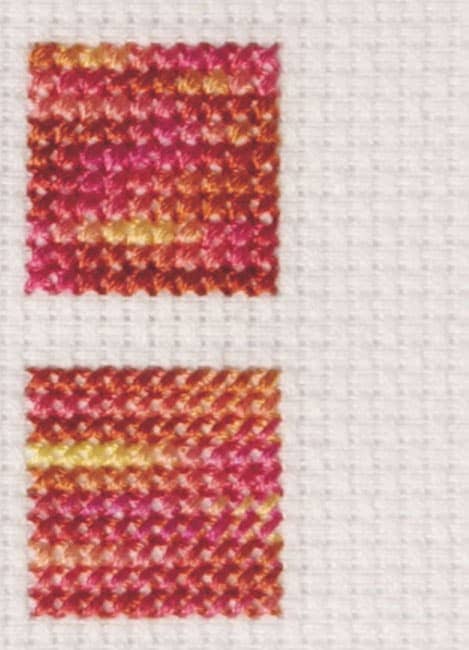What you will need
Cross stitch does not demand an expensive initial outlay to get you started. Fabric, thread, needles, and an embroidery hoop are all you need to begin stitching. You will then find that as you collect unused fabric and extra threads you can build up a useful embroidery kit for future projects.
Fabric
There are two main varieties of fabric used for cross stitch work, referred to as evenweave and Aida fabrics, although Aida is still evenly woven. Either of these evenweave fabrics make a good choice for cross stitch because the evenly woven warp and weft threads allow the cross stitches to be made of identical size and to be positioned accurately on the fabric.
Evenweave fabric Evenweave fabric has the same number of warp and weft threads woven to every 1 in. (2.5cm) of fabric. The number of threads is called the count and this number varies depending on the weight of the individual threads. The most popular sizes are 28- and 36-count, which contain 28 or 36 threads to every 1 in. (2.5cm). Cross stitch is usually worked over pairs of evenweave threads rather than single threads, which means that when you stitch on 28-count evenweave you can fit 14 stitches into 1 in. (2.5cm) of fabric.
Evenweave fabric can be made from linen, cotton, or a blend that may contain synthetic fibers such as polyester.

26-count evenweave linen, 26-count evenweave cotton, and 32-count evenweave linen.
Aida fabric The most popular evenly woven cotton fabric for cross stitch is called Aida, and varies in appearance to the traditional evenweave fabric described above. For Aida, groups of even-sized threads are woven together to produce a series of distinct blocks, over which individual stitches are worked. The blocks are easy to count accurately so this fabric is perfect for a beginner. Like traditional evenweave, Aida is available in different counts: 14-count Aida—14 blocks to 1 in. (2.5cm)—is one of the most widely used sizes, allowing you to fit 14 stitches to every 1 in. (2.5cm) of fabric; 11-count Aida—11 blocks to 1 in. (2.5cm)—has a larger weave so stitches are bigger, while stitches worked on 16- or 18-count are smaller.

18-count cream Aida, 14-count beige Aida, 14-count pink Aida, and 14-count cream Aida with lurex.
Cross stitch bands Narrow bands of fabric made specifically for cross stitch are available by the yard or meter in various widths. They are useful for trimming items of home furnishing as well as for making small items such as bookmarks and scented sachets. The central portion of the bands is made from either evenweave linen or Aida and the top and bottom edges are prefinished with a decorative edging. The bands can be bought in several colors and they are usually woven with 14 blocks or 28 threads to every 1 in. (2.5cm).
Fabric counts Two strawberries (motif 149, page 58) have been stitched in cotton floss on different counts of cross stitch fabric.

SAMPLE 1 was stitched on 11-count Aida fabric using three strands of floss for the cross stitches and two strands for the backstitch outlines.
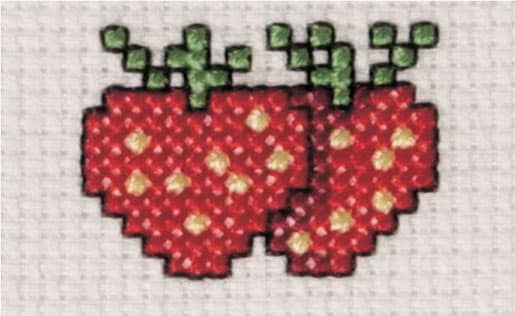
SAMPLE 2 was stitched on 14-count Aida fabric using two strands of floss for the cross stitches and one strand for the backstitch outlines.
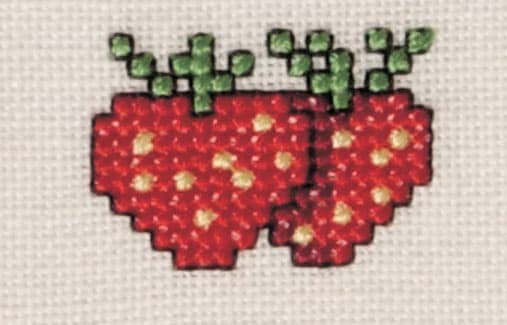
SAMPLE 3 was stitched over two threads of 28-count evenweave linen using two strands of floss for the cross stitches and one strand for the backstitch outlines.
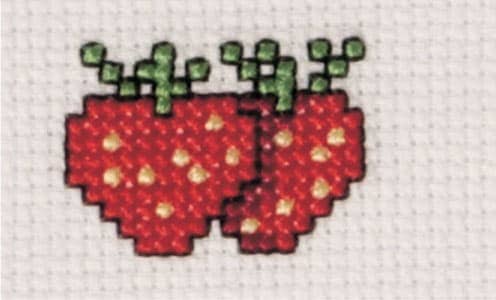
SAMPLE 4 was stitched on 16-count Aida using two strands of floss for the cross stitches and one strand for the backstitch outlines.
Threads
Stranded cotton floss is most commonly used for cross stitch, but silk, rayon, specialty, or metallic threads can also be experimented with for varying effects.
Cotton floss Cotton floss is the most versatile thread to use for cross stitch. It is available in a wide range of colors and consists of six loosely twisted strands of mercerized cotton. A cut length of floss can be split into different weights to suit different fabric counts. As a general rule, use two strands for stitching on 14-count Aida fabric or over two threads on 28-count evenweave fabric, and three strands for stitching on 11-count Aida fabric. Use floss in 15–18-in. (38–45-cm) lengths to avoid tangling.
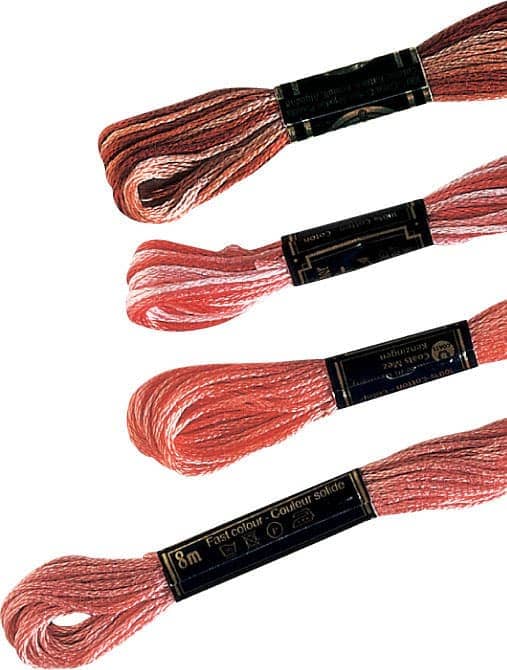

Rayon and silk floss Floss is also made from rayon or pure silk. Both types are slightly more expensive but they have a delightful sheen and the colors are vibrant. When using rayon or silk floss, cut a shorter length than usual and choose a tapestry needle with a large enough eye to accommodate the thread comfortably, otherwise it will rub and fray each time you pull the needle through the fabric. Take care to finish off the thread ends carefully when stitching with rayon thread, which is fairly springy.
Specialty threads Over-dyed and hand-painted floss, often known as specialty threads, offer a wide range of color mixtures and effects, depending on the manufacturer. Several different shades or colors are applied to the thread at fixed intervals so that they blend into each other. These threads are more expensive than cotton floss in solid colors so should be used in small amounts to add an extra special dash of color to a design.
Metallic threads Like specialty threads (left) metallic threads can be used to add accents of color and sparkle to a design. They are available in metallic, pearlized, and fluorescent finishes and in varying weights, so choose one to suit the count of fabric you are using. Fine braid No. 4 works well on 14-count Aida and 28-count evenweave fabric.
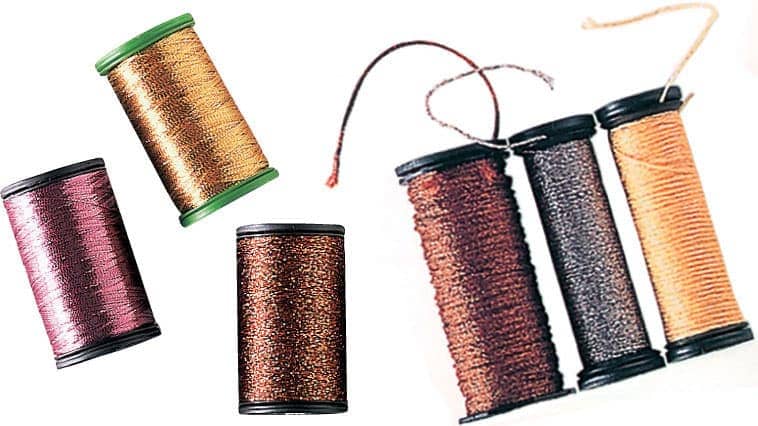
Needles
Tapestry needles are ideal for use with all evenweave fabrics because their blunt points slide easily through the material without pulling or tearing. These needles are available in different sizes, graded from thick—the low numbers—to fine—the high numbers. The most useful sizes for cross stitch are 24, 26, and 28.
Hoops and frames
For all but the smallest designs, mounting the fabric in a circular hoop or rectangular frame will help you to stitch evenly and accurately.
Embroidery hoops are available in various sizes and consist of two circular sections placed one inside the other. The fabric is sandwiched between the two sections and secured by a screw at the side. The advantage of using a hoop is that it can be moved across the fabric once each portion of the design has been completed.
Rectangular frames consist of straight wooden bars that slot together and, like hoops, are available in a good range of sizes. The fabric is attached to the frame using thumb tacks. Unlike a hoop, a frame cannot be moved across the fabric so choose one to suit the size of your work, ensuring that unsightly tack marks do not run into the finished piece.
Graph paper and design materials
Graph paper is an essential design tool, along with a pen, scissors, and ruler. Using this basic equipment you can choose any number of motifs and combine and space them to create a pleasing arrangement.
Beads
To add interest to a stitched design you can substitute glass seed beads for some of the cross stitches. Size 11 seed beads fit the weave of 14-count Aida or 28-count evenweave fabric perfectly, so you can apply one bead to one Aida block or pair of evenweave threads. Use a special beading needle or the finest gauge of crewel needle (size 10) to work the stitches when applying beads and match the thread color to the fabric background, not to the color of the bead.

USING BEADS Green and gold seed beads have been used for the foliage and pips instead of green and yellow cross stitches on these two strawberries (motif 149, page 58) stitched on 14-count Aida using two strands of cotton floss.
